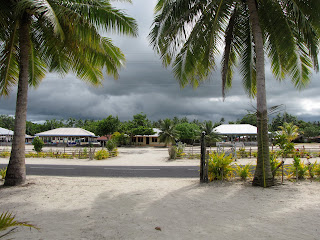
Our first day was a big travel day, but that didn’t keep up from stopping at the first convenient turn off and spending some time talking about the landscape and reflecting via psalm writing, something that would become a class fixture throughout the next two weeks. As the Canterbury plains gave way to tussock grassland in the pass and later on beech forest, the weather, which had been bright and sunny on the East Coast, became overcast and it began to rain. By the time we pulled over to explore a beech forest later in the afternoon everyone could appreciate the phrase “temperate rain forest.” It was at this point that we saw several cool things, one being a New Zealand Robin which Alex and Scott coaxed over by brushing away some of the duff on the forest floor so it could find worms. The other thing that we saw was Caleb tasting Horopito for the first time. He liked it so much he put it on his sandwiches for the rest of the trip.
During the first part of the week our whole group stayed at the Bruce Bay Marae, a meeting-house for the Maori community in that area. Our hosts graciously welcomed us with a Powheri ceremony before we ate dinner together. Bruce Bay is a beautiful spot located on the edge of a Kahikitea swamp half way between Hokitika and Haast. The sun set over the ocean there, we could see the Southern Alps (when it wasn’t overcast), and there was a wealth of ecosystems to explore at our fingertips.

Each person had a different highlight of the week, however a few might include,
- Seeing not one but TWO glaciers.
- Examining a deceased Australian Possum (an invasive species with opposable thumbs).
- Being enraptured by the sight of Hector’s Dolphins, the smallest dolphins in the world.
- Sleeping in the Wharenui i.e. “House of Sleeping” with everyone else
- Passing a Weka... while driving at 90 km per hour... this still counts as a life bird, right?
- Examining epiphytes
- Learning how to tell the difference between a Miro and a Rimu.
- Taking pictures, of EVERYTHING!
We left the Marae after saying goodbye to Maria, our host, and drove back up towards Arthur’s Pass. On our way, while stocking up on groceries in Hokitika, our professor, Cal, noticed a prominent sign that said “National Kiwi House,” with the words “Tuatara,” and “Giant Eels” in smaller letters underneath. The good news was that Cal had actually done extensive research on the Tuatara several years ago. Upon hearing this, the staff of the National Kiwi House welcomed our entire group into their center to see their Tuatara, feed the giant eels, and see and actually TOUCH real live Kiwi birds. The birds they had were both bred in captivity but will be released into the wild once the reached four years of age. The birds are carefully monitored here, as New Zealanders try to do all they can to help out this iconic endangered species.

After seeing Kiwi birds, everyone climbed back into the vans and we headed off towards Arthur’s Pass, taking altimeter readings along the way. We rolled into Arthur’s Pass about the same time as the rain clouds and made ourselves at home in the “Arthur’s Pass Outdoor Education Centre,” a cozy lodge that caters to school group and has an excellent library of books about New Zealand.
Our final day in the field was spent visiting a beech forest, exploring Alpine tussock meadows and feeling the earth move when we walked on an alpine peat bog. Scott and Alex discovered an exciting tree species called the “Mountain Nei nei,” however due to the rather lighthearted sound of the tree name, no one believed them for quite some time. Thanks to their persistence, we all know now that this tree species can be identified by the photograph on page 76 of Dawson and Lucas’ New Zealand plant guide.
Despite some of our grand plans to go hiking on our day off in Arthur’s Pass, a massive rain storm rolled in, and we woke on Sunday morning to the sight of sheets of rain blowing in front of the mountains. Some of us made use of our rain suits and went hiking anyway, while others visited the local coffee shop, curled up with a book or enjoyed a somewhat heated game of Settlers in front of the stove.

By Monday most of us were ready to be home and needed to do laundry. Upon our return, the dining room at the Convent turned into a computer lab for the rest of the week as Cal, Abe and students organized data, previous research, and heaps of photographs into a cohesive presentation detailing how altitude, latitude and rainfall affect the location of different ecosystems on New Zealand’s South Island. The long hours paid off in the end because Marcel made popcorn that we ate during the big research presentation on Friday night.
It’s hard to believe that there are only a few more weeks of the semester left. Everyone is starting to tick off things “on the bucket list” at a rapid pace, and the Convent is busy with campus improvement projects and additional secrets and surprises.

































